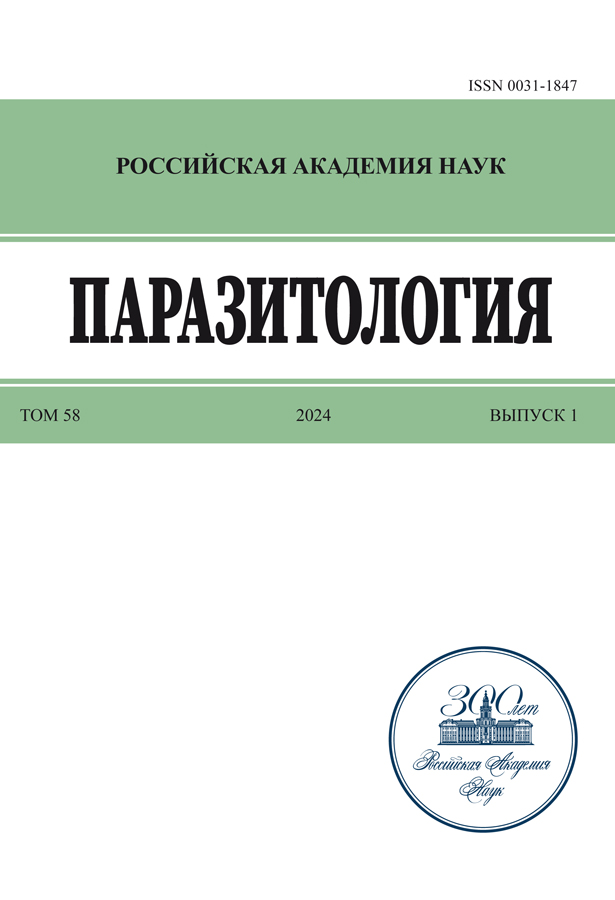Phylogenetic position of Polymorphus phippsi Kostylew, 1922 and Polymorphus magnus Skrjabin, 1913 (Palaeacanthocephala, Polymorphidae) ascertained on the basis of molecular data
- 作者: Diumina A.V.1, Galaktionov K.V.1, Atrashkevich G.I.2
-
隶属关系:
- Zoological Istitute of Russian Academy of Sciences
- Institute of the Biological Problems of the North Far East Branch of Russian Academy of Sciences
- 期: 卷 58, 编号 1 (2024)
- 页面: 56-63
- 栏目: Articles
- URL: https://rjeid.com/0031-1847/article/view/670182
- DOI: https://doi.org/10.31857/S0031184724010058
- EDN: https://elibrary.ru/SSJCAF
- ID: 670182
如何引用文章
详细
Polymorphidae is a family of acanthocephalans, obligatory parasites with a complex life cycle involving arthropods as intermediate hosts and vertebrates of different taxa as definitive hosts. The current taxonomy of Polymorphidae seems to be equivocal. Its type genus Polymorphus has been shown to be polyphyletic based on molecular data. We obtained partial sequences of 28S rDNA gene and cox1 mitochondrial gene of two species of this genus, Polymorphus phippsi and P. magnus, and used them in a reconstruction of the polymorphid phylogeny. As a result, P. magnus was included into the same clade as the type species of the genus, P. minutus, while P. phippsi appeared to be close to Profilicollis spp. The position of P. phippsi agrees with the polyphyly of Polymorphus but does not correspond to its taxonomic status based on described phenotypic characters.
全文:
作者简介
A. Diumina
Zoological Istitute of Russian Academy of Sciences
编辑信件的主要联系方式.
Email: aleksandra.diumina@zin.ru
俄罗斯联邦, Universitetskaya emb., 1, Saint-Petersburg, 199034
K. Galaktionov
Zoological Istitute of Russian Academy of Sciences
Email: kirill.galaktionov@zin.ru
俄罗斯联邦, Universitetskaya emb., 1, Saint-Petersburg, 199034
G. Atrashkevich
Institute of the Biological Problems of the North Far East Branch of Russian Academy of Sciences
Email: gatr@ibpn.ru
俄罗斯联邦, Portovaya str., 18, Magadan, 685000
参考
- Ahlrichs W.H. 1997. Epidermal ultrastructure of Seison nebaliae and Seison annulatus, and a comparison of epidermal structures within the Gnathifera. Zoomorphology 117 (1): 41–48.
- Amin O.M. 2013. Classification of the Acanthocephala. Folia Parasitologica 60 (4): 273–305.
- De Lamballerie X., Zandotti C., Vignoli C., Bollet C., De Micco P. 1992. A one-step microbial DNA extraction method using “Chelex 100” suitable for gene amplification. Research in Microbiology 143 (8): 785–790.
- Folmer O., Black M., Hoeh W., Lutz R., Vrijenhoek R. 1994. Phylogenetic uncertainty. Molecular Marine Biology Biotechnology 3: 294–299.
- García-Varela M., Pérez-Ponce de León G., de la Torre P., Cummings M.P., Sarma S.S.S., Laclette J.P. 2000. Phylogenetic relationships of Acanthocephala based on analysis of 18S ribosomal RNA gene sequences. Journal of Molecular Evolution 50: 532–540.
- García-Varela M., Nadler S.A. 2005. Phylogenetic relationships of Palaeacanthocephala (Acanthocephala) inferred from SSU and LSU rDNA gene sequences. Journal of Parasitology 91(6): 1401–1409.
- García-Varela M., de León G.P.P., Aznar F.J., Nadler S.A. 2013. Phylogenetic relationship among genera of Polymorphidae (Acanthocephala), inferred from nuclear and mitochondrial gene sequences. Molecular Phylogenetics and Evolution 68(2) 176–184.
- Gouy M., Guindon S., Gascuel O. 2010. SeaView version 4: a multiplatform graphical user interface for sequence alignment and phylogenetic tree building. Molecular Biology and Evolution 27(2): 211–224.
- Khokhlova I.G. 1986. Acanthocephala of terrestrial vertebrates of the USSR. Moscow, Nauka, 275 pp. [In Russian].
- Miller M.A., Pfeiffer W., Schwartz T. 2010. Creating the CIPRES Science Gateway for inference of large phylogenetic trees // 2010 gateway computing environments workshop (GCE). Ieee 1–8.
- Monks S. 2001. Phylogeny of the Acanthocephala based on morphological characters // Systematic Parasitology 48(2): 81–115.
- Ronquist F., Eslenko M., Van der Mark P., Ayres D.L., Arling A.D., Höhn S., Larget B., Suchard M.A., Huelsenbeck J.P.H. 2012. MrBayes 3.2: efficient Bayesian phylogenetic inference and model choice across a large model space // Systematic biology 61 (3): 539–542.
- Sharpilo V.P., Salamatin R. 2005. Paratenic parasitism: origins and development of the concept. Ukraine, Kyiv, Logos, 237 pp. [In Russian].
- Smales L. 2015. Acanthocephala. In: Schmidt-Rhaesa A. (Ed.) Handbook of Zoology. V. 3. Gastrotricha, Cycloneuralia, Gnathifera. De Gruyter Publ., 317–336.
- Tamura K., Stecher G., Kumar S. 2021. MEGA11: molecular evolutionary genetics analysis version 11. 38(7): 3022–3027.
- Uspenskaya A.V. 1963. The parasite fauna of deep-water Crustacea in East Murmansk. Moscow-Leningrad, USSR Academy of Sciences, 128 pp.
补充文件










